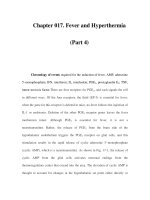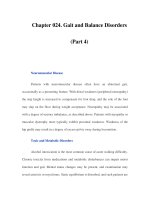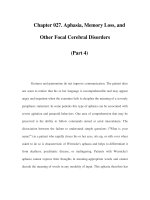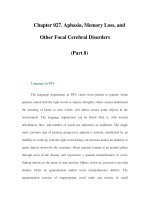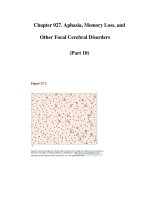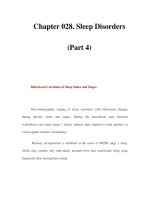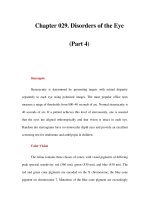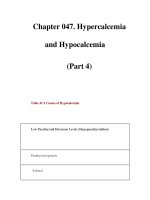Chapter 110. Coagulation Disorders (Part 4) potx
Bạn đang xem bản rút gọn của tài liệu. Xem và tải ngay bản đầy đủ của tài liệu tại đây (44.09 KB, 5 trang )
Chapter 110. Coagulation Disorders
(Part 4)
Factor VIII and Factor IX are dosed in units. One unit is by definition the
amount of FVIII (100 ng/mL) or FIX (5 µg/mL) in 1 mL of normal plasma. One
unit of FVIII per kilogram of body weight increases the plasma FVIII level by 2%.
One can calculate the dose needed to increase FVIII levels to 100% in a 70-kg
severe hemophilia patient (<1%) using the simple formula below. Thus, 3500 units
of FVIII will raise the circulating level to 100%.
FVIII dose (IU) = Target FVIII levels – FVIII baseline levels x body
weight (kg) x 0.5 unit/kg
The doses for FIX replacement are different from those for FVIII, because
FIX recovery postinfusion is usually only 50% of the predicted value. Therefore,
the formula for FIX replacement is
FIX dose (IU) = Target FIX levels – FIX baseline levels x body weight (kg)
x 1.0 unit/kg
The FVIII half-life of 8–12 h requires injections twice a day to maintain
therapeutic levels, whereas the FIX half-life is longer, ~24 h, so that once-a-day
injection is sufficient. In specific situations such as postsurgery, continuous
infusion of factor may be desirable because of its safety in achieving sustained
factor levels at a lower total cost.
Cryoprecipitate is enriched with FVIII protein (each bag contains ~80 IU of
FVIII) and was commonly used for the treatment of hemophilia A decades ago; it
is still in use in some developing countries, but because of the risk of bloodborne
diseases, this product should be avoided in hemophilia patients when factor
concentrates are available.
Mild bleeds such as uncomplicated hemarthroses or superficial hematomas
require initial therapy with factor levels of 30–50%. Additional doses to maintain
levels of 15–25% for 2 or 3 days are indicated for severe hemarthroses, especially
when these episodes affect the "target joint." Large hematomas, or bleeds into
deep muscles, require factor levels of 50% or even higher if the clinical symptoms
do not improve, and factor replacement may be required for a period of 1 week or
longer. The control of serious bleeds, including those that affect the oropharyngeal
spaces, central nervous system, and the retroperitoneum, require sustained protein
levels of 50–100% for 7–10 days. Prophylactic replacement for surgery is aimed at
achieving normal factor levels (100%) for a period of 7–10 days; replacement can
then be tapered depending on the extent of the surgical wounds. Oral surgery is
associated with extensive tissue damage, which usually requires factor
replacement for 1–3 days coupled with oral antifibrinolytic drugs.
Non-Transfusion Therapy in Hemophilia
DDAVP (1-Deamino-8-D-Arginine Vasopressin)
DDAVP is a synthetic vasopressin analogue that causes a transient rise in
FVIII and von Willebrand factor (vWF), but not FIX, through a mechanism
involving release from endothelial cells. Patients with moderate or mild
hemophilia A should be tested to determine if they respond to DDAVP before a
therapeutic application. DDAVP at doses of 0.3 µg/kg body weight infused over a
20-min period is expected to raise FVIII levels by two- to threefold over baseline,
peaking between 30–60 min postinfusion. DDAVP does not improve FVIII levels
in severe hemophilia A patients, as there are no stores to release. Repeated dosing
of DDAVP results in tachyphylaxis because the mechanism is an increase in
release rather than de novo synthesis of FVIII and vWF. More than three
consecutive doses become ineffective and if further therapy is indicated, FVIII
replacement is required to achieve hemostasis.
Antifibrinolytic Drugs
Bleeding in the gums, in the gastrointestinal tract, and during oral surgery
requires the use of oral antifibrinolytic drugs such as ε-aminocaproic acid (EACA)
or tranexamic acid to control local hemostasis. The duration of the treatment
depending on the clinical indication is 1 week or longer. Tranexamic acid is given
at doses of 25 mg/kg three to four times a day. EACA treatment requires a loading
dose of 200 mg/kg (maximum of 10 g) followed by 100 mg/kg (maximum 30 g/d)
every 6 h. These drugs are not indicated to control hematuria because of the risk of
formation of an occlusive clot in the lumen of genitourinary tract structures.
Complications
Inhibitor Formation
The formation of alloantibodies to FVIII or FIX is currently the major
complication of hemophilia treatment. The prevalence of inhibitors to FVIII is
estimated at 5–10% of all cases and approximately 20% of severe hemophilia A
patients. Inhibitors to FIX are detected in only 3–5% of all hemophilia B patients.
The high-risk group for inhibitor formation includes severe deficiency (>80% of
all cases of inhibitors), familial history of inhibitors, African descent, mutations in
the FVIII or FIX gene resulting in deletion of large coding regions, or gross gene
rearrangements. Inhibitors usually appear early in life, at a median of two years of
age, and after 10 cumulative days of exposure.
